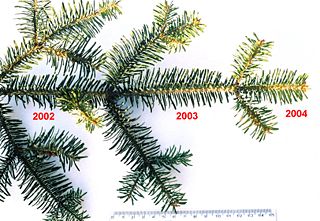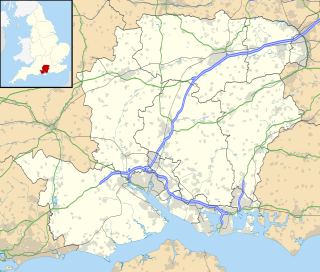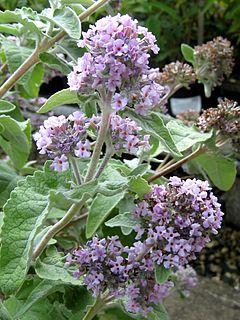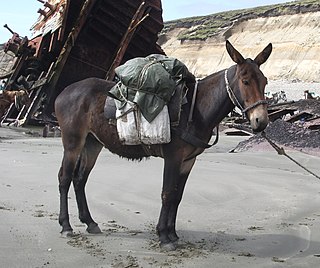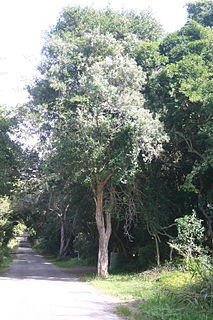
Buddleja saligna, the false, or bastard, olive, is almost endemic to South Africa where it has a wide distribution. It occurs most often in ravines and against outcrops, and is distributed from coastal elevations to the central plateau at elevations of < 2000 m. The species was first described and named by Willdenow in 1809.

Buddleja salviifolia, common names sage bush and sagewood, is endemic to much of southern and eastern Africa, from Kenya and Angola south, where it grows on rocky hillsides, along forest margins and watercourses. The species was described and named by Lamarck in 1792.
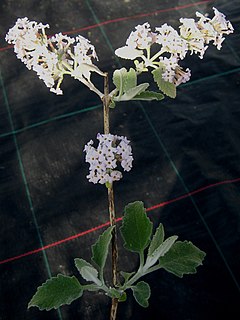
Buddleja sterniana was a species sunk as Buddleja crispa by Leeuwenberg in 1979, and treated as such in the subsequent Flora of China. however, the plant remains widely known by its former epithet in horticulture.
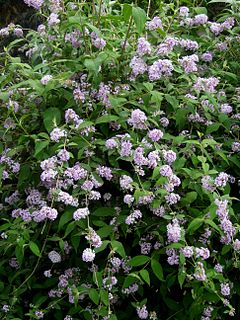
Buddleja delavayi is a Chinese species discovered by Forrest in the Tali Range above Dali, Yunnan, in 1910; it is also found in Xizang (Tibet). The species was named for l'Abbé Delavay, the French missionary and plant collector, by Gagnepain in 1912. The shrub is of interest to the botanist because of its unique resting buds and the different types of inflorescence produced through the year.
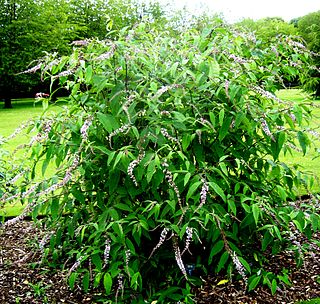
Buddleja albiflora is a deciduous shrub native to the mountains of central China, where it grows on shrub-clad slopes at altitudes of between 1,000 and 2,000 m. Named rather carelessly by Hemsley, the species was discovered by Henry, and introduced to western cultivation by Wilson in 1900.

Buddleja auriculata is an evergreen shrub endemic to Zimbabwe, Mozambique, and South Africa, growing in montane fields and thickets at elevations of 600–2,000 m. First collected by W. J. Burchell in 1813, and named by Bentham, the date of its introduction to western cultivation is not known, however it was accorded the Royal Horticultural Society Award of Merit in 1923.

Buddleja agathosma is endemic to western Yunnan, China. Originally identified as B. agathosma by Ludwig Diels, it was sunk as Buddleja crispa by Leeuwenberg in 1979, and treated as such in the subsequent Flora of China published in 1996. However, the shrub remains widely known by its former epithet in horticulture.

Buddleja glomerata is a shrub endemic to the mountains of the Karoo desert in South Africa, where it grows among boulders on dry hillsides. The species was first described and named by Heinrich Wendland in 1825. The shrub has a number of common names locally, the most popular being 'Karoo Sagewood'.

Buddleja asiatica is a somewhat tender deciduous shrub native to a vast area of the East Indies, including India, Nepal, Bangladesh, China, Taiwan, Burma, Thailand, Laos, Cambodia, Vietnam, Malaysia, New Guinea, and the Philippines, growing in open woodland at elevations < 2,800 m either as understorey scrub, or as a small tree. First described by Loureiro in 1790, B. asiatica was introduced to the UK in 1874, and accorded the RHS Award of Garden Merit in 1993. It is highly invasive in Hawaii, Guam, and the Northern Mariana Islands.

Buddleja coriacea is a variable species endemic to the high Andes from the Cordillera Blanca in Peru to Lake Titicaca in Bolivia. It grows on dry to semi-humid rocky soils at elevations of 3,000–4,350 m, where temperatures range from -3° to 15° C. and the winds are both strong and persistent. The species was first named and described by Rémy in 1847.

Buddleja cordata is endemic to Mexico, growing along forest edges and water courses at elevations of 1500–3000 m; it has also naturalized in parts of Ethiopia. The species was first described and named by Kunth in 1818.
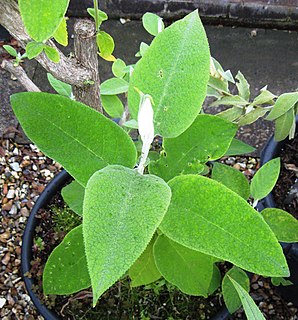
Buddleja crotonoides is a shrub with a wide distribution, from California south to Nicaragua. The shrub grows at elevations of 2,000–2,500 m in oak woods and on scree in association with Arbutus xalapiensis, Pinus sp., and Crataegus mexicana. B. crotonoides was first named and described by Gray in 1847.
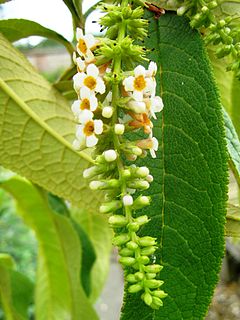
Buddleja forrestii is a deciduous shrub or small tree widely distributed from India to western China. First described by Diels in 1912, he named the species for plant hunter George Forrest, who discovered the plant in Yunnan in 1904 and introduced it to Western cultivation.

Buddleja japonica is a deciduous shrub native to Honshu and Shikoku, Japan, where it grows on mountain slopes amid scrub. The shrub was named and described by Hemsley in 1889, and introduced to Western cultivation in 1896.

Buddleja nivea is a vigorous shrub endemic to western China, evergreen in the wild, but deciduous in cultivation in the UK. The plant was discovered by Wilson in the Yangtze basin at altitudes of 700 – 3,600 m. Introduced to cultivation in 1901, it was named by Duthie in 1905. Several plants similar to the species but originally treated as species and varieties in their own right have now been sunk as B. nivea.
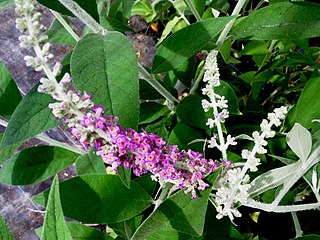
Buddleja stenostachya is a deciduous shrub native to Szechuan province, China. The species was discovered and introduced to cultivation by Wilson in 1908, and named by him and Rehder in 1913. There remains some contention over its taxonomy; it was sunk under B. nivea by Leeuwenberg; while another erroneously sank it as a variety of Buddleja crispa.
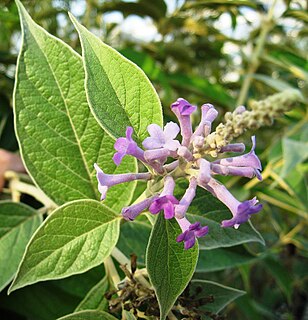
Buddleja myriantha is a species endemic to upper Burma and western China, including Tibet, where it grows along forest edges, thickets and streams at altitudes of 2,000 – 3,200 m. The species was first described and named by Diels in 1912.

Buddleja davidii 'Autumn Beauty' is a British cultivar distinguished solely by its comparatively late flowering, from August through to October. The shrub was cloned from a plant grown from seed sent from Beijing to Paignton Zoo, one of the four NCCPG national buddleja collection holders. The atypical phenology of the shrub has cast doubt on its taxonomy as a variety or form of Buddleja davidii, however its flowers, foliage and structure are all very similar to the species.
Buddleja × lewisiana 'Margaret Pike' is a cultivar of the hybrid Buddleja madagascariensis × Buddleja asiatica raised by A V Pike at Hever Castle, England, in 1951. The shrub was accorded the Award of Merit (AM) by the Royal Horticultural Society in 1953, followed by the First Class Certificate (FCC) in 1954.
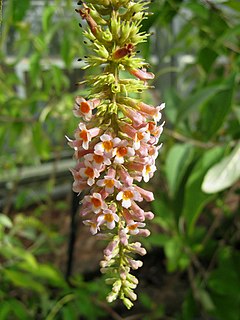
Buddleja macrostachya is a large deciduous shrub or small tree with a vast distribution, from Xizang (Tibet) through western China, Bhutan, Sikkim, northern India, Bangladesh, Myanmar (Burma), to Thailand and Vietnam, growing in scrub on mountain slopes to an altitude of 3,200 m, and along rivers in forests. The species was named and described by Wallich ex Bentham in 1835.

